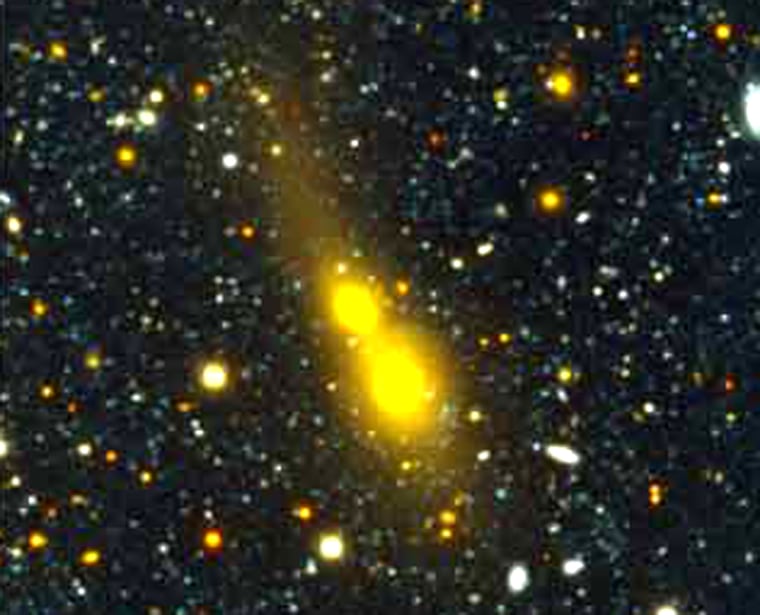There’s room in the universe for thousands of galaxies but that doesn’t stop them from running into each other. New observations support the idea that galaxies are in constant interaction with each other and that the biggest ones get bigger by engulfing smaller ones.
These observations confirm a long-standing theory about how the universe works in general and sheds light on how things got started in the first place.
"This is the way that everything in the universe was formed," said Pieter van Dokkum of Yale University. "It’s a never-ending story of things colliding — small things colliding to make big things, big things colliding to make bigger things. These are the events that shape today’s galaxies."
The theory goes like this: The universe was a fairly smooth place following the Big Bang, but there were little bits of substructure material that attracted matter and began to grow. As time passed, these clumps grew bigger and bigger. Through gravitational forces, the bigger ones began attracting some of the smaller clumps, collided, and merged with them, forming what we know as galaxies today.

Although this logic seemed reasonable to many scientists, they didn’t have much evidence that these large bodies actually interacted with each other. Confusing the matter, the most massive galaxies also appear to be the oldest, which would have left very little time since the Big Bang for them to form via mergers.
Now, van Dokkum’s multiple deep-field observations — taken with the National Science Foundation’s 4-meter telescopes at Kitt Peak National Observatory and Cerro Tololo Inter-American Observatory — display the telltale signs of inter-galactic interactions.
Van Dokkum selected 126 nearby red galaxies, chosen because of their massive size, and began searching for signs of gravitational influence from outside sources, such as tails, broad fans of trailing stars, or other obvious asymmetries. Although these features are faint, they turned out to be quite common, showing up in 53 percent of the galaxies.
"It shows that these galaxies are not in equilibrium, that something is pulling stars out of these galaxies," van Dokkum told Space.com. "On this scale the only thing we know of that can do this is another galaxy, and we can actually see that."
These observations also show that these merges happen fast — which is probably why they were difficult to spot before now.
"Well, fast is a few hundred million years. That’s fast compared to the age of the universe," van Dokkum said. While that doesn’t seem very fast, it’s quick enough to account for those old, massive galaxies.
This research, which is detailed in the Dec. issue of Astrophysical Journal, also helps solve the long-standing problem for judging a galaxy’s age. Previously, astronomers equated the age of stars with the age of the galaxy, even though sometimes the galaxies appeared much younger than the stars.
"We have found that, though their stars are generally old, the galaxies that result from these mergers are relatively young," van Dokkum said.
Galaxies smashing into one another sounds like an explosive event. On the contrary, they probably slide together smoothly, generating little fanfare. Galaxies are mostly empty space, and the distance between stars is so huge that the probability of stars colliding is actually very small.
There is still a chance for a violent explosion though, especially if the central black holes of the merging galaxies collide and merge. "This event could be so powerful that it could cause ripples in space time," said van Dokkum.
One would think that two galaxies mixing together would create a hot-bed for star formation. Cosmic gas is the fuel for star formation, and the idea is that the same tidal forces that pull these stars away from their galaxies will also compress the gas and lead to the formation of new stars
But collisions like these surprisingly spark very little, if any, new star formation. One possible reason is that the galaxy has already used up all its gas forming the stars already there.
"Or, at a previous point the central black hole created so much energy that it pushed the gas out of these galaxies," van Dokkum said. "That is what’s next on the agenda to figure out."
It doesn’t appear that the Milky Way has a collision rich history, van Dokkum said, mainly because it has a very large, intact disc that a merge or collision would have disrupted. But that could change soon — the Andromeda galaxy M31 lurks just 2.3 million light years away and is on a crash course for the Milky Way.
"The Milky Way will collide in the future, in about 4 billion years with the galaxy Andromeda and that collision will lead to formation of a much bigger galaxy," van Dokkum said. "So we have that to look forward to."
